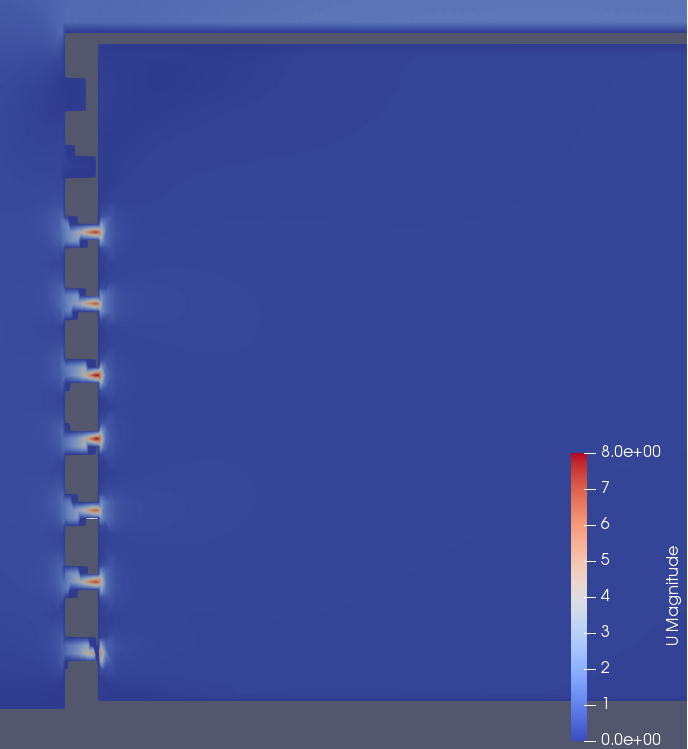Wind Effects on Buildings
With this blog post we would like to hit on a sample from the multitudes of complex factors affecting the built environment in an urban context. These factors will aid or inhibit a designer’s ability to utilize wind to provide a better internal climate for the users of our buildings. One may not first think of Wind when considering Heat and Light within or around a building, although, it can be channeled to ventilate (remove heat) or blocked to stop cold winter air (retain heat). Downdraught and updraught can be broken up by sunshades (modulate light and heat). In desert environments wind chimneys have been used for a long time as an ideal passive cooling and ventilation strategy. In the urban environment there may be new ways for designers to utilize wind, that is often chaotic, once it can be directed and focused. Through simulation and analysis urban planners, architects and engineers now have more possibilities than ever to digitally understand our surroundings, we hope these tools will become commonplace in the industry bringing computation to the average buildings.
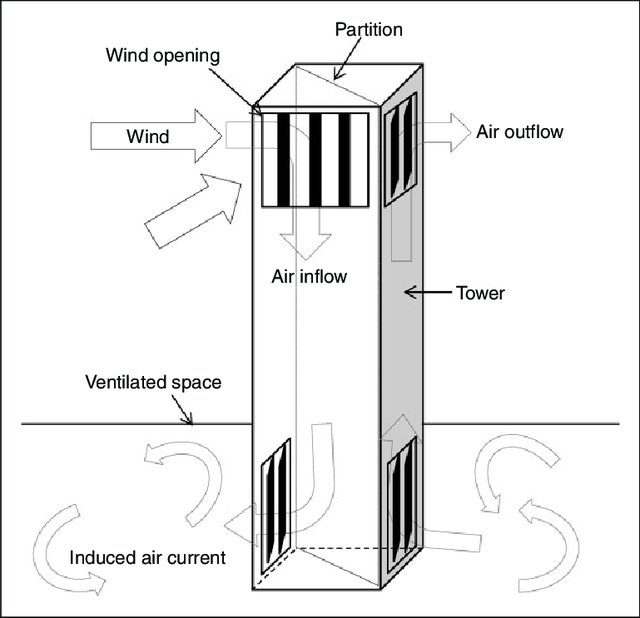
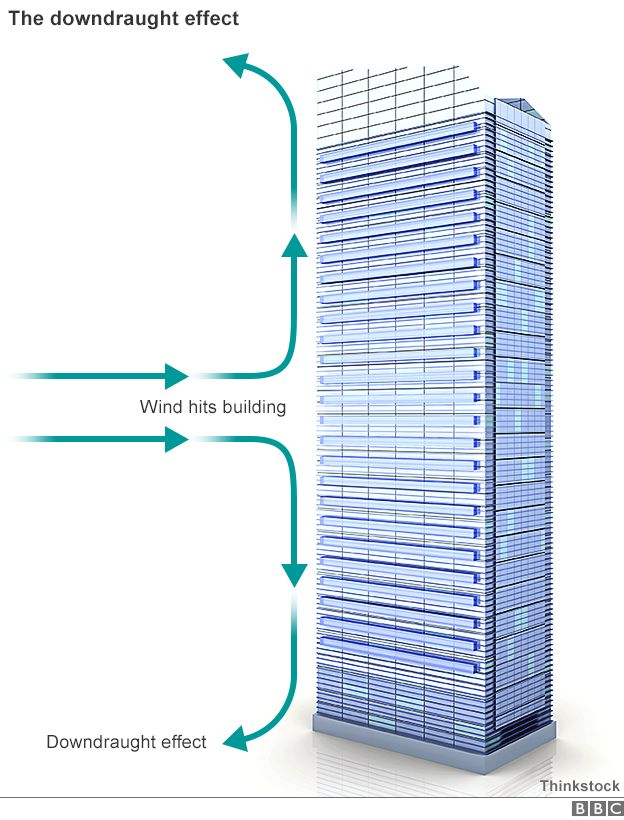
Within the urban environment there are a handful of different wind situations to be utilized or diverted. First is when the wind direction is near perpendicular to the façade of a building, this initially will induce lateral loading on the structure and this is why some tall towers are shaped to have minimal wind impact. This wind will hit the façade and travel in a multitude of different directions, up and over, to the sides and around, or down and spiraling in the pedestrian zone. The result is increased wind speed around the corners and base of the building that can create high turbulence in its surroundings and discomfort or even dangerous situations for pedestrians.
While physical wind tunnel testing on skyscraper designs to ensure building safety and prevent structural damage is common, it is just now becoming accessible for architects to study designs with digital wind tunnels before the final design is tested in a physical wind tunnel. Moreover, the assessment of wind effect on the microclimate, personal comfort and business impact within the surroundings of a building has become increasingly important and common, particularly in urban environments. During the design of the Burj Khalifa in Dubai (2010), the tallest building in the world, wind analyses were done to study the effects at the base and terraces of the building. In London, wind microclimate studies (Pedestrian Wind Comfort) are required as part of planning applications of new development proposals to guarantee certain levels of comfort at street level.
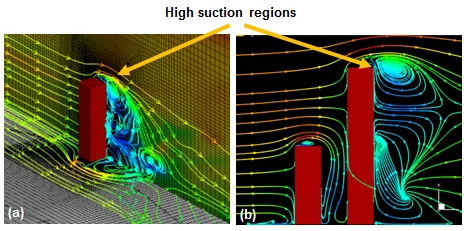
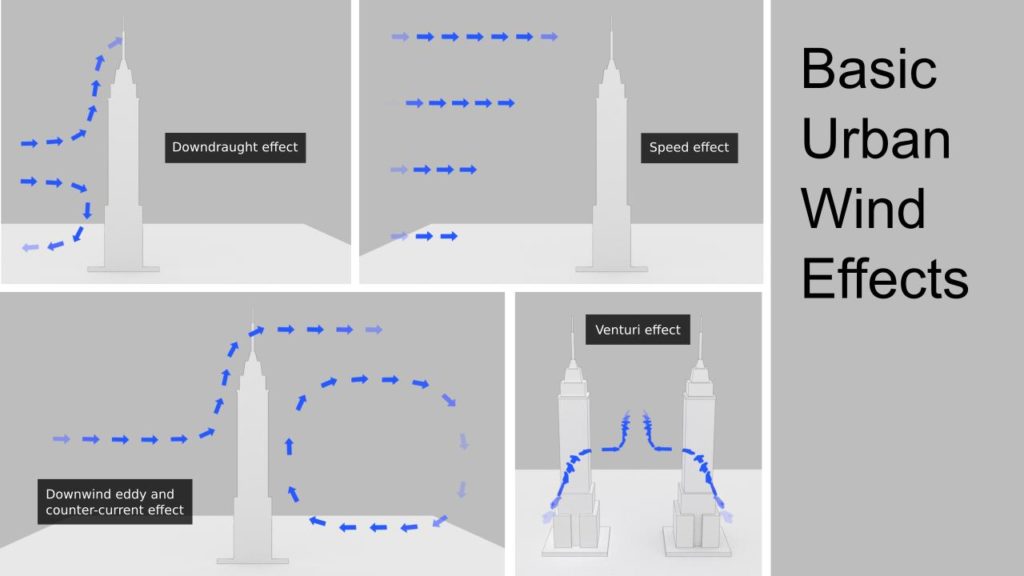
Natural Ventilation Techniques (tower façade or smaller structures)
Wind acceleration through a narrow passage as a result of pressure difference around a building or between the interior and exterior of a structure is explained by the Venturi effect, a general principle of fluid dynamics which states that air speed increases when static pressure decreases. This mechanism can be exploited to create natural ventilation. As shown in the images below, this is one of many studies related to this topic. This study shows how a simple change at the ridge of a roof would allow for greater passive ventilation than a structure without this type of ventilation, the windows in most buildings are not effective in providing ventilation as the boundary condition of the facade is rarely interrupted at each window opening. Although, this is another avenue of investigation.
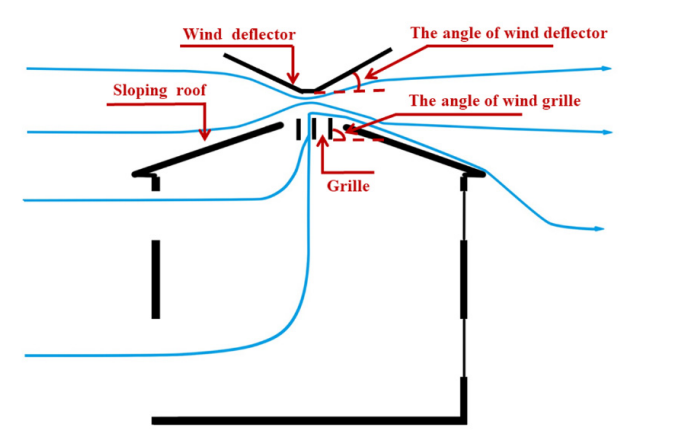
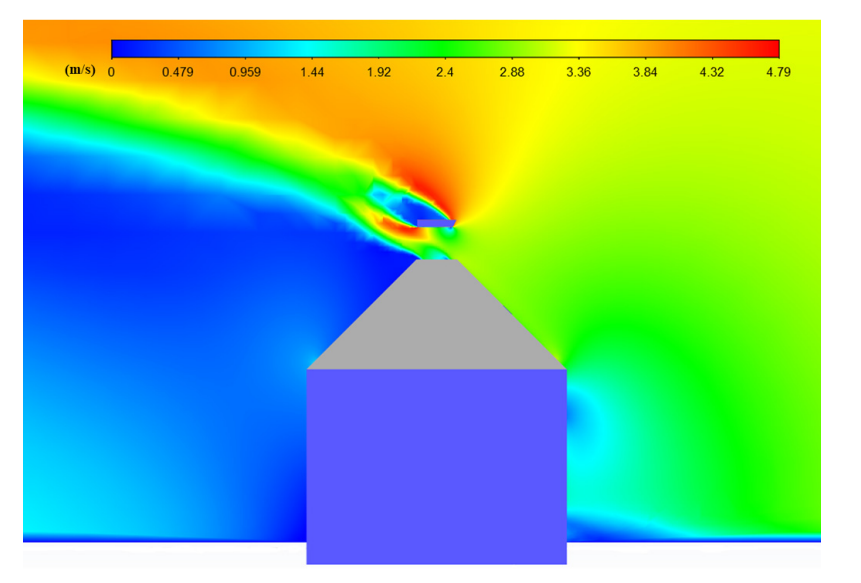
The stack effect is the tendency of air to move vertically through tall buildings or chimneys as a result of vertical pressure developed by thermal buoyancy – simply put, hot air rises. Rising warm air creates positive pressure at the top of a building and negative pressure at lower levels where cooler outside air is drawn in. This effect can and should be integrated as part of the building design to reduce the use of mechanical ventilation. For taller buildings there are a few options for taking advantage of the stack effect. At the exterior is the possibility for a double skin system where there is a captured column of air that heats up causing air movement and convection. At the interior of a building multi-story atriums such as those employed in the Commerzbank building in Frankfurt, Germany by Foster & Partners where the larger volume of air can more easily manage the pressure difference between outside and inside. These atriums are bounded internally by office floorplates where occupants have views outside while having the ability to naturally ventilate their work area via access to the atrium.
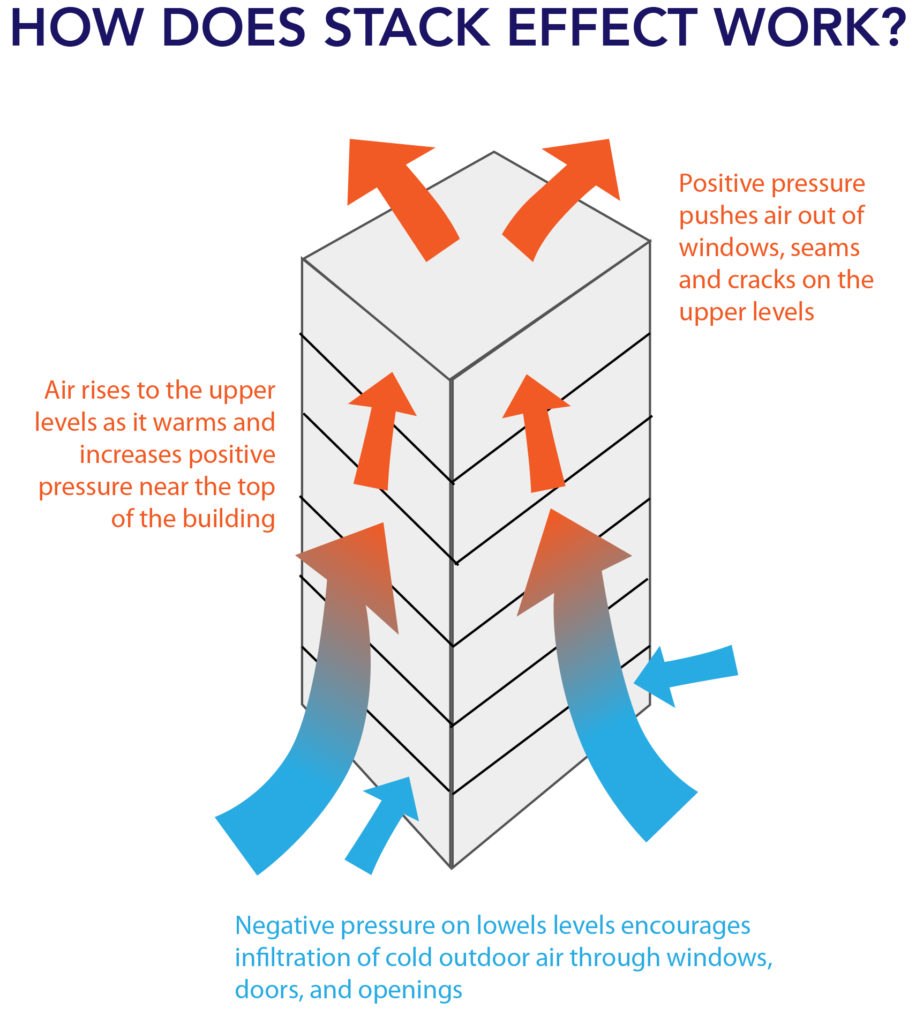
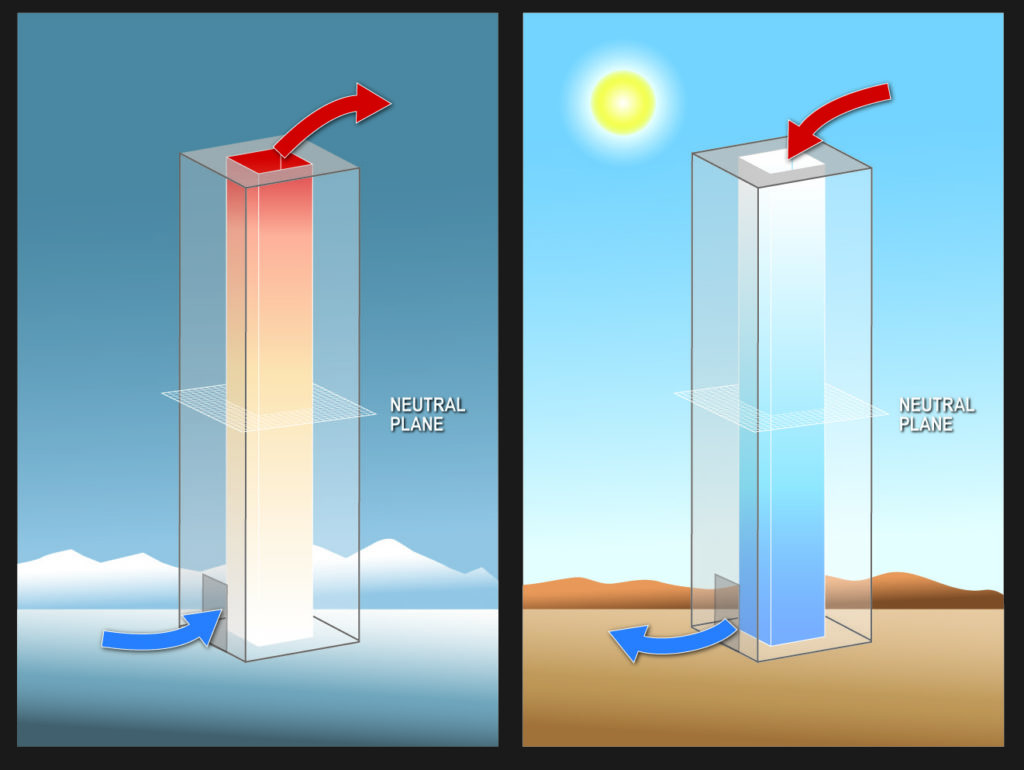
Urban Heat Island Effect
Another phenomenon to consider is the Urban Heat Island (UHI) effect caused by replacement of natural land with hardscape, which absorb and retains heat, causing increases in air temperature while resulting in increased energy consumption and pollution. Designers should be encouraged to design more biophilic urban spaces which will aid in lowering the heat absorption. Cities such as Los Angeles, CA have started trials with applying traffic coatings with high albedo values, calling the project Cool Streets LA. Of course that is merely dealing with a single symptom of the urban condition. Beyond mitigating local microclimates within an urban area, the weather files designers use for environmental analysis may not accurately depict conditions within these urban areas, thus some researchers have started developing ways to modify existing weather files to better estimate the Urban Heat Island Effect. One of the papers we read was “Urban Weather Generator – a Novel Workflow for Integrating Urban Heat Island Effect within Urban Design Process” which goes into detail how they created the Urban Weather Generator website and technology. By utilizing tools such as this, designers and architects will be better prepared to determine the cooling and heating degree days integral in many environmental analysis, specifically EUI and predicted energy savings.
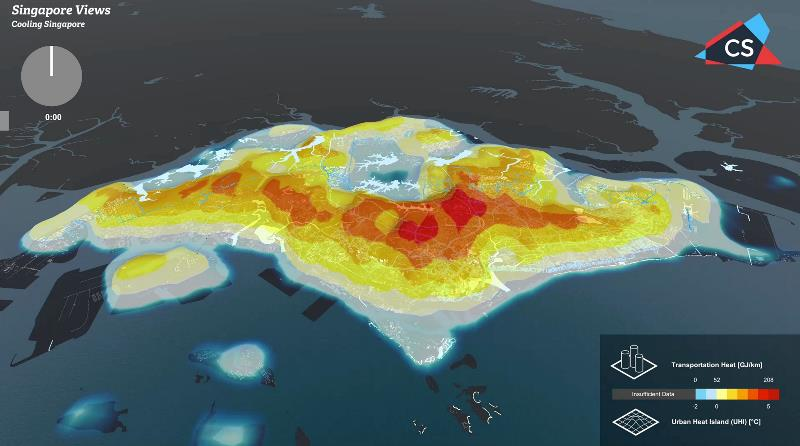
Breathing Skins Referential Research
Upon reading many papers on the topic of Heat & Light we were most drawn to the research paper “Breathing Skins for Wind Modulation Through Morphology” by: Mehrnoush Latifi, Daniel Prohasky, Jane Burry, Rafael Moya, Jesse McCarty and Simon Watkins from RMIT Melbourne, Australia.
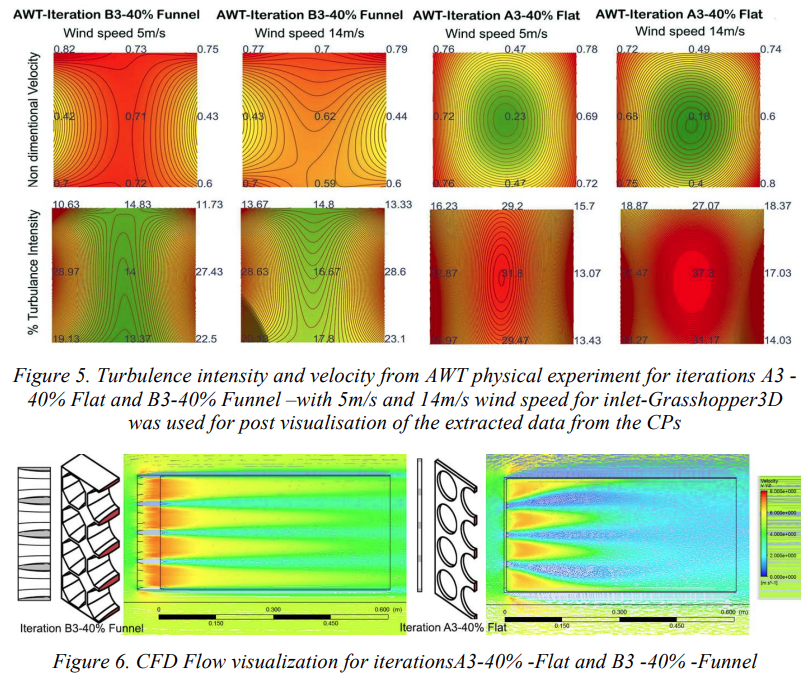
Beyond the exciting concepts raised in the research paper, it instigated a idea within us, to engage the boundary layer wind activation at the façade of a skyscraper. In an urban environment typical HAWTs (Horizontal Axis Wind Turbines) have terrible efficiency due to the variation of wind speed, direction and the level of turbulent flow found within the city. There have been some projects where HAWTs are installed at the top of a building to access the wind updraught. Although, there might be a lost opportunity to utilize smaller scale VAWTs (Vertical Axis Wind Turbines) in a more building integrated situation. This could be at the corner of a building, where pressure builds, like a parking garage in Chicago (see image). The shape of the tower / building could also be used to funnel and direct the wind (organize) to focus the flow to a bank or grid of VAWTs.
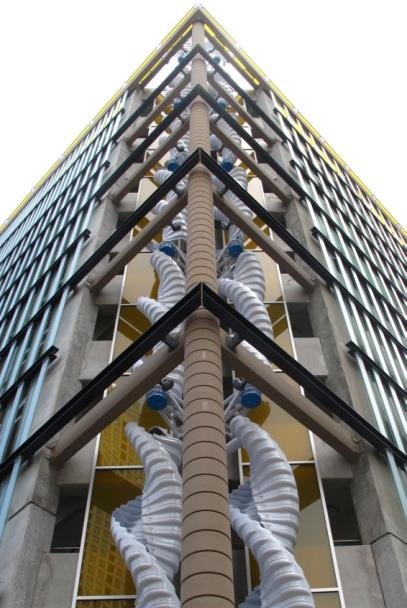
This figure was uploaded by Mladen Bošnjakovi? to Flickr
In reading the research paper: Breathing Skins for Wind Modulation Through Morphology we were excited by the idea of screening a façade, to reduce the solar heat gain and glare while also the potential of funneling wind (organizing) to be used in natural ventilation or possibly energy generation. Depending on the scale, the focal point of the funnel could be designed where a VAWT would be placed within the optimal acceleration location. Through other reading / research (Design and Analysis of Vertical Axis Wind Turbine by Nabin Sapkota and Ranjan Kumar Sapkota https://www.irjet.net/archives/V6/i9/IRJET-V6I9238.pdf) it has been found that VAWTs operate well at many wind speeds from as low as 3m/s up to 40 m/s, some reach a functional energy output at 8-11m/s which is right in line with the data shown in the research paper for air speeds coming out of the funnels.
Alternately, within a ventilated cavity with the cells of air funnels from the research paper it would accelerate the wind into the cavity, this could be directed up or down, where the vertical axis wind turbines would use the focused air to turn the urban wind into renewable energy. While when the wind is not strong or directed at the façade, the convection and stack effect would come into play to produce air flow that could also rotate the turbines. While during a highly windy time a downdraught within the cavity may be created that could amplify the movement of air and thus turning turbines.
Solar Heat Gain is an important element in building design and occupant comfort, at times it needs to be blocked and at others allowed to penetrate into the building. The proposal instigated by the paper would include a algorithmic determination for the shading skin of the building to modulate the porosity of the screening elements, thus accelerate or direct the air while also focusing and organizing the flow. This grid would fluctuate between open for vision and more closed for wind harvesting. The concept, to be researched further in the future, would be to incorporate a grid of vertical axis wind turbines placed behind the screen, in harvesting areas, in the exact location where the acceleration is maximized locally.
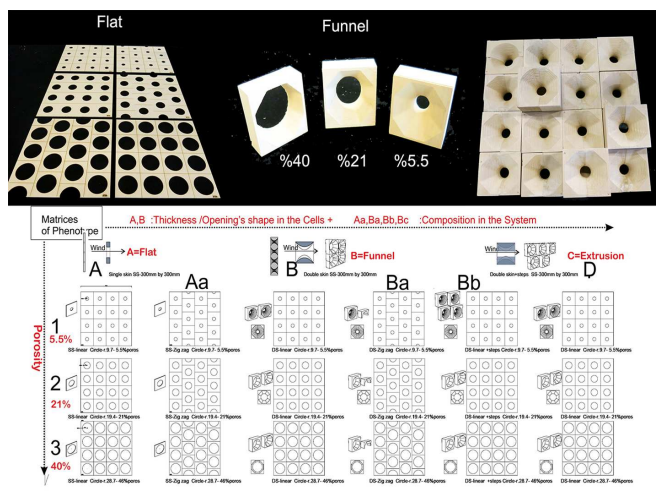
We have performed some research with the aid of the Ladybug Butterfly plugin for Grasshopper. We now have a better understanding of the efforts the research team went through for the testing reported in their paper. More research is required on our end to provide a better understanding of the possibilities of our ignited imaginations.
